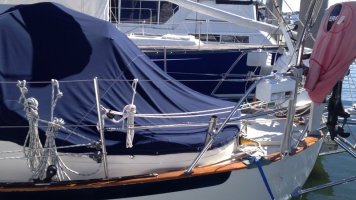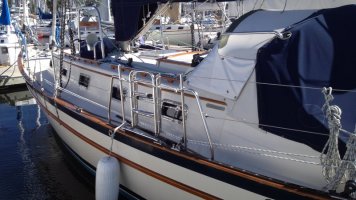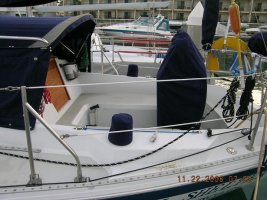You are using an out of date browser. It may not display this or other websites correctly.
You should upgrade or use an alternative browser.
You should upgrade or use an alternative browser.
Furling line of friction....
- Thread starter Rick R.
- Start date
Frank Langer
1984 Ericson 30+, Nanaimo, BC
On our E30+ the furling line has a ratchet block on a stanchion just aft of the lifeline gate, also along the port side. From there the furling line rests in a cam cleat just forward of the winch. When rolling it up, I simply release it (upwards) from the cam cleat, haul on the furling line with my right hand while holding the jib sheets with very slight tension in my left hand, standing in front of the steering pedestal. The furling line is well above the fibreglass and causes no damage. This system works well, and my wife also finds it convenient. I don't know if it would work equally well on an E32.
Frank
Frank
Rick R.
Contributing Partner
Frank, we have the cam cleat just on the outside of the winch. From there to the cockpit is where the chafe is occurring. Do you have a picture of your set up?ThanksOn our E30+ the furling line has a ratchet block on a stanchion just aft of the lifeline gate, also along the port side. From there the furling line rests in a cam cleat just forward of the winch. When rolling it up, I simply release it (upwards) from the cam cleat, haul on the furling line with my right hand while holding the jib sheets with very slight tension in my left hand, standing in front of the steering pedestal. The furling line is well above the fibreglass and causes no damage. This system works well, and my wife also finds it convenient. I don't know if it would work equally well on an E32.Frank
Frank Langer
1984 Ericson 30+, Nanaimo, BC
I'm not at the boat so can't take a pic, and I've reviewed the pics on my computer but none show the furling line set-up in a helpful way.
However, the cam cleat is placed forward of the cockpit winch a couple of inches where the fibreglass coaming narrows as it reaches the forward end of the cockpit. When I haul on the furling line, it is well above the coaming as I'm holding it in my hand while standing in the cockpit forward of the pedestal, so no chance for it to rub.
I think placement of the final ratchet block several inches above the deck on the stanchion support leg is key to the furling line being at the right angle to not touch the fibreglass.
Hope that helps a bit.
Frank
However, the cam cleat is placed forward of the cockpit winch a couple of inches where the fibreglass coaming narrows as it reaches the forward end of the cockpit. When I haul on the furling line, it is well above the coaming as I'm holding it in my hand while standing in the cockpit forward of the pedestal, so no chance for it to rub.
I think placement of the final ratchet block several inches above the deck on the stanchion support leg is key to the furling line being at the right angle to not touch the fibreglass.
Hope that helps a bit.
Frank
Tom Metzger
Sustaining Partner
Rick R.
Contributing Partner
That's what I need Tom!ThanksI took a lot of pix of the PS/E-333 (which is the same boat as the E-32-200) before my son bought it. Here is the furling line turning on a ratchet block on the stern rail stanchion.
mherrcat
Contributing Partner
Here's my rig. I happened to have a fiddle block with cam cleat in the garage. It works well. Quite strong, lies peacefully when not in use, turns for an easy pull/release from the helm.
Needs to be strong. There's a very yar Pacific Seacraft 38 near me with two cam blocks for twin roller headstays. The stanchion they're strapped to is bent 15 degrees from the strain.

Needs to be strong. There's a very yar Pacific Seacraft 38 near me with two cam blocks for twin roller headstays. The stanchion they're strapped to is bent 15 degrees from the strain.


Last edited:
Mort Fligelman
Member III
Roller Furling Block and leads
Rick and all.......
I use the same Harken lead block on my port side stern pulpit forward upright......I have a Harken Rope clutch about three feet in front of the block so no way a gust can let the line go......I have the line leading from the furler going through 3 Ronstan Roller bearing Blocks which really takes the friction out of the line.
As an aside, and not trying to be a wise guy, a bent Stantion on a PS 38 tells me there is an improper procedure in the furling method. FWIW.....in pretty windy conditions I get turned almost dead downwind on a starboard tack (furling lead on port side and sail rolls clockwise) and blanket the sail with the main....also run the engine hard enough so there is very little to no pressure on the sail......as I said....FWIW....my .02 worth
Rick and all.......
I use the same Harken lead block on my port side stern pulpit forward upright......I have a Harken Rope clutch about three feet in front of the block so no way a gust can let the line go......I have the line leading from the furler going through 3 Ronstan Roller bearing Blocks which really takes the friction out of the line.
As an aside, and not trying to be a wise guy, a bent Stantion on a PS 38 tells me there is an improper procedure in the furling method. FWIW.....in pretty windy conditions I get turned almost dead downwind on a starboard tack (furling lead on port side and sail rolls clockwise) and blanket the sail with the main....also run the engine hard enough so there is very little to no pressure on the sail......as I said....FWIW....my .02 worth
Tom Metzger
Sustaining Partner
Some years ago I had a conversation with Harken about using a winch on the furling line because some other manufacturer said it was OK. They said "never" not because the furling gear wouldn't take the forces, but because there is too great of a chance that something other than the wind is causing the problem. For instance a knot in the line or a wrapped halyard.
About that bent stanchion--
I often study the PS 38--I think that's what it is--because it has all the gear, including a Monitor vane, and hasn't a scratch anywhere on it. The varnish is redone twice a year, which the contractor explainedito me is the right way to do it--before any slightest sign of wear appears. This in answer to my question, "how come you're varnishing that brand new varnish?"
It may well be that a winch was applied, although wouldn't we say that the blocks are just fixed too high on an unsupported stanchion? They have a very clean run forward through stanchion rollers.
It appears he has the windvane lines on the same stanchion, too. Hmmm.


I often study the PS 38--I think that's what it is--because it has all the gear, including a Monitor vane, and hasn't a scratch anywhere on it. The varnish is redone twice a year, which the contractor explainedito me is the right way to do it--before any slightest sign of wear appears. This in answer to my question, "how come you're varnishing that brand new varnish?"
It may well be that a winch was applied, although wouldn't we say that the blocks are just fixed too high on an unsupported stanchion? They have a very clean run forward through stanchion rollers.
It appears he has the windvane lines on the same stanchion, too. Hmmm.



![En Douce 011 [800x600].jpg](/ie/data/attachments/9/9378-00a1b02d20b8335258d8d695be91a062.jpg)
